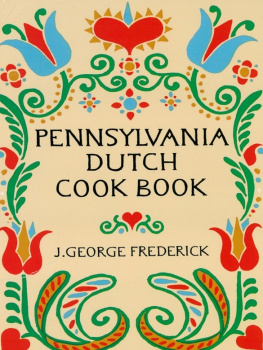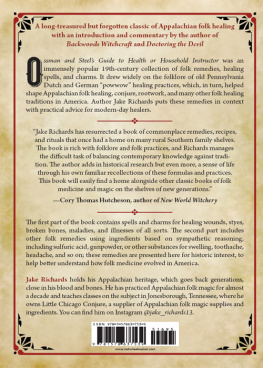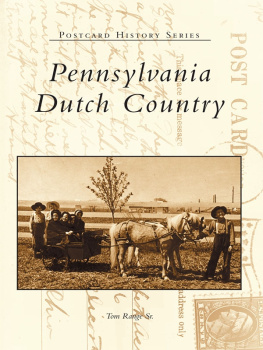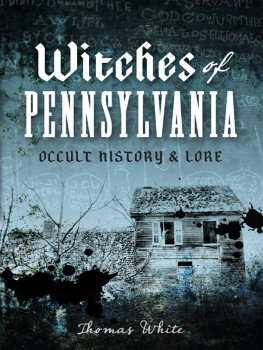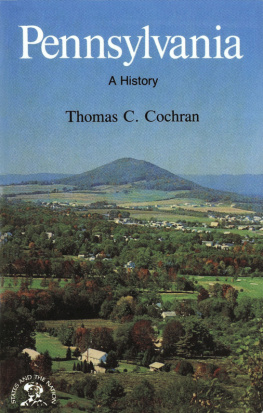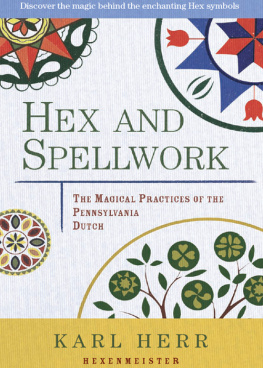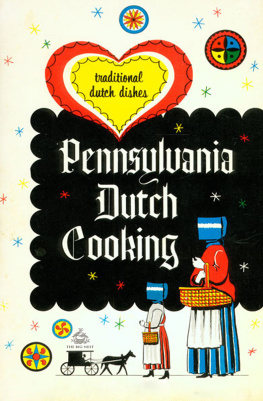Folk Religion of the Pennsylvania Dutch
Witchcraft, Faith Healing and Related Practices
RICHARD L.T. ORTH

McFarland & Company, Inc., Publishers
Jefferson, North Carolina
LIBRARY OF CONGRESS CATALOGUING DATA ARE AVAILABLE
BRITISH LIBRARY CATALOGUING DATA ARE AVAILABLE
e-ISBN: 978-1-4766-3074-8
2018 Richard L.T. Orth. All rights reserved
No part of this book may be reproduced or transmitted in any form or by any means, electronic or mechanical, including photocopying or recording, or by any information storage and retrieval system, without permission in writing from the publisher.
Front cover: a barn (avowed to be the Most Beautifully Decorated in America, with hex signs; a Pennsylvania Dutch farmwife pouring milk at a stove; 11-inch hand carved figure (circa 1900) used in a Powwow cure to break a Hexerei spell (photographs from a private collection used with permission)
McFarland & Company, Inc., Publishers
Box 611, Jefferson, North Carolina 28640
www.mcfarlandpub.com
This book is dedicated
to my longtime mentor, Richard H. Shaner.
Thank you for being my friend and remaining by my side
all these years even in the most tumultuous of times.
I hope you can accept my departure
and thank you!
Preface
Among Auslanders (outsiders) observing the Pennsylvania Dutch Country, and even some who are part of the Pennsylvania Dutch folk culture through its descended community, the practice of Powwowing is often confused with Hexerei. As in most of Western civilization, there has long existed (and still exists) among the Germanic Dutch people a belief in white and black magic. The art of white magic in the Dutch Country is referred to as Braucherei or, more popularly, Powwowing. Hexerei, of course, is the art of black magic. Powers used to heal in the art of Braucherei are derived from God (the Holy Trinity), but the powers employed in Hexerei are derived from the Devil, in the simplest explanation. Therefore, one who engages in this sort of dark magic has bartered or sold his soul to the Devil and is destined for Hell, so practitioners beware!
For nearly three centuries, the Pennsylvania Dutch have not hesitated to use Braucherei in the healing of their sick and afflicted, and, regionally, the culture has canonized early 19th-century faith healer Mountain Mary (of the Oley Hills) as a saint for her healing powers. But we will get more into her remarkable story later (as well as that of her contemporary, John George Hohman, who published numerous early 19th-century books on the matter). This form of faith healing has many counterparts in our civilization; however, the subset of Hexerei, witchcraft, or black magic was always considered the utmost form of evil in the region, and only desperate people (and those with devious intentions) have resorted to its equally powerful and secret powers.
Yet dating back even earlier than the widespread use of Braucherei and Hexerei in the Pennsylvania Dutch Country, among the oldtime traditions of the Pennsylvania Dutch people, are the 18th-century broadside amulets that have been handed down since colonial times. These amulets evolved into iconic good luck charms among devout Christian families who lived in southeastern Pennsylvania, which included French Huguenot pioneers, also grouped as Pennsylvania Dutch, along with some who lived in New York State with the Holland Dutch, a distantly different group/heritage (I will elaborate below). Always written in the German Pennsylvania Dutch dialect, these Himmelsbriefs, published in German, were amulets of religious folk beliefs and a reminder of native Christian folklife in that they protected each family from evil, house fire, and unfortunate health hazards as long as members practiced a Christian lifestyle.
Pennsylvania Dutch is the original term used by William Penns English colonists here and abroad to describe these immigrants from Rhineland Germany, and it refers to this Rhenish German civilization of native Palatines covered throughout this book. This cultural group includes not just Germans but also French Huguenots, Swiss Amish and Mennonites, Holland Dutch Mennonites, and Moravians. Collectively, these people shared a German vernacular and, in arriving in America in large waves from the same geographic region, they sought farms in Pennsylvania (Penns Woods) and nearly outnumbered William Penns English immigrants.
This early American cultural melting pot, located in southeastern Pennsylvania, included these naturalized Rhineland citizens who swore allegiance to the United States but also assimilated with English laws and standards. However, in terms of everyday work habits and living customs (folk religion included), they followed in their native Rhineland fashion and continued their unique German dialect in America, which soon became known as Pennsylvania Dutch rather than formal High German. Pennsylvania Dutch, as a colonial English-created colloquialism, was a more precise Americanism, indicating a broader group of individuals from Europes Rhine Valley with preRevolutionary roots, as opposed to, say, Pennsylvania Germans or German Americans. Many scholars interchange the terms (Pennsylvania Dutch with Pennsylvania Germans), and some use the latter exclusively; however, neither option is the preference of this author.
A Hexerei Vocabulary
The word hex (witch) is but one of several terms from the Pennsylvania Dutch dialect that have been assimilated into American English. It has been accepted by American lexicographers and is recognized in most standard dictionaries. The following is a simple vocabulary list of variations on hex as it was used in the Dutch Country.
FERHEXT: bewitched
HEXA-BRIEF: a piece of paper with Hexerei formulae written on it
HEXA-FOO: witch star or foot
HEXA-HEWWEL: witch stick with a mysterious moving propeller
HEXBALLA: witch ball; a ball of hair found in a cows stomach at butchering time
HEX BOOK: witch book; a book containing occult knowledge
HEX DOCTOR: witch doctor
HEXESCHUSS: a shot fired to kill or drive out a witch
HEXING: bewitching
HEX-RING: a circular spot of ground where nothing will grow
HEX-SIGN: a geometric design painted on the forebay or front of a barn in certain parts of the Dutch Country
HEX-SPELL: witch spell
WAFFLE-HEX: a circular waffle produced from a rosette-type iron
Part I
White and Black Magic
of the Pennsylvania
Dutch Country
1
Hexerei
An Introduction
A Practice of Witchcraft
The occult practice of witchcraft among the Pennsylvania Dutch, despite its longevity, has rarely been accurately presented to the public. There is undoubtedly no other field in which the Pennsylvania Dutch folkways have been more misunderstood than the practice of Hexerei. From the earliest years of the 18th century to the present day, Hexerei has remained an underground belief and practice, and only in the last 40 years has enough evidence been collected to present a detailed study on the subject.
Pennsylvania Dutch witchcraft has been traced to Europe, and is similar to that which was popular in medieval times, but its persistence among the Dutch in America is due in part to the publication of various occult books and the efforts of several people to make a living from this practice. In almost every community, existing side by side with the practice of Braucherei was the cautious belief in Hexerei. The most astonishing fact about black and white magic among the Pennsylvania Dutch is that they did exist prevalently, and they actually worked. Cases upon cases are recorded from all parts of the Pennsylvania Dutch Country in which the powers of black and white magic have been successful. It is this success, more than anything else, that has kept these two supernatural forces alive in the culture even in todays world.


